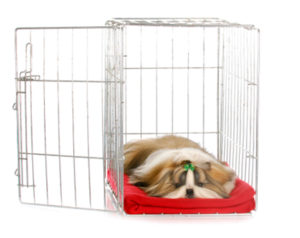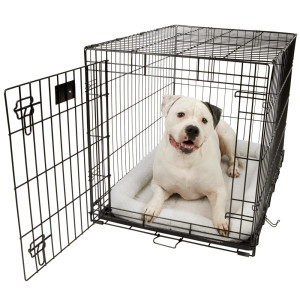Crate training made easy
By Delores Burton—K-9 Campus
 Many people regard putting a dog into a crate or kennel as being cruel. Actually it is just the opposite. How you approach crate training will make the difference between your dog loving or hating his kennel. If you follow these simple instructions, you and your dog will be on the way to a happier more secure feeling of well-being.
Many people regard putting a dog into a crate or kennel as being cruel. Actually it is just the opposite. How you approach crate training will make the difference between your dog loving or hating his kennel. If you follow these simple instructions, you and your dog will be on the way to a happier more secure feeling of well-being.
Dogs by nature are denning animals. They enjoy being in an enclosed area where they can get away from the hustle and bustle. It is their little getaway or private bedroom. It gives them a feeling of security and contentment. How many of you have dogs that have a favorite spot in a corner, under an end table or behind your headboard?
Crate training your dog also protects your pet from injuring himself when he is left alone or needs to travel safely from one destination to another. It also greatly facilitates housebreaking your dog or puppy.
The kennel should be just big enough for him to stand up and turn around comfortably. Any larger and he will find room to relieve himself inside the crate, which is not what you desire. Dogs do not like to relieve themselves where they eat or sleep.
Never use your crate or kennel as a punishment or a prison. Make it fun for your dog to go inside the crate. Start to feed him in the crate. If he doesn’t want to go in, put his food or a treat just inside the door and gradually move it further and further back.
Make it comfortable for your dog. Be sure there is proper ventilation. Put in a cozy blanket or pad. Put in a favorite toy. Reward him with a treat when he goes in. Place the crate in an area where he can see what’s going on and be with the family, but not in a traffic area. That way he won’t feel isolated, but he can take a nap if he wants to.
Once he is going into the crate voluntarily or on command, start to close the door for short periods of time, but stay close by so he doesn’t feel he is being “locked up”. Gradually increase the length of time and also the distance. Never let your dog out if he is crying, barking or whining. Always wait until he settles down before opening the door. If you do let him out when he is fussing, you will be rewarding bad behavior and one that is hard to break. 
As your dog gets accustomed to being in the crate, repeat the same steps above, but leave the room and increase the length of time. If he whines, you can return to comfort him by letting him know you are not deserting him, but do not let him out of the crate when he is whining.
During the day, a dog should be let out of the crate at least every 4 hours. Puppies may need to be taken out more frequently. If you leave a dog in a crate longer than he is able to hold it, you can create housebreaking problems that will be very difficult to correct.
Now that you know how easy it is to crate train your dog, you will be ready for my next article “Housebreaking in a Hurry”.
